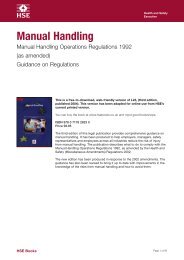Making Companies Safe - what works? (CCA ... - Unite the Union
Making Companies Safe - what works? (CCA ... - Unite the Union
Making Companies Safe - what works? (CCA ... - Unite the Union
Create successful ePaper yourself
Turn your PDF publications into a flip-book with our unique Google optimized e-Paper software.
Chapter Five<br />
The Health and <strong>Safe</strong>ty Executive (HSE) has described enforcement as:<br />
“activities directly associated with ensuring duty holders discharge <strong>the</strong>ir legal<br />
duties. Techniques may include giving advice (written and oral), withdrawing<br />
approvals, varying licences, serving notices, issuing cautions, prosecuting. The<br />
term implies <strong>the</strong> possibility of escalation if <strong>the</strong> dutyholder does not act<br />
appropriately.” 5<br />
HSE and Local Authority (LA) inspectors enforce <strong>the</strong> law mainly in <strong>the</strong> context of preventative<br />
inspections and investigations of workplaces.<br />
During preventative inspections, HSE and LA inspectors will assess <strong>the</strong> extent to which<br />
employers are complying with <strong>the</strong>ir legal duties and how effectively <strong>the</strong>y are managing<br />
workplace risks. Where standards are judged to be inadequate, inspectors attempt to prompt<br />
employers to take remedial action by offering advice, or by imposing enforcement notices.<br />
If <strong>the</strong> breach is serious enough, or if <strong>the</strong> company has failed to comply with advice or<br />
enforcement notices in <strong>the</strong> past, <strong>the</strong> inspector should, in addition to taking remedial action,<br />
consider whe<strong>the</strong>r or not to prosecute. 6<br />
Prosecution following an inspection is intended to serve a number of different functions. For<br />
instance, it is intended to deter <strong>the</strong> particular organisation from breaching <strong>the</strong> law in <strong>the</strong><br />
future and it also serves a more general deterrence purpose in that it indicates to o<strong>the</strong>r<br />
organisations that <strong>the</strong>y can expect to be punished if <strong>the</strong>y are found to have broken <strong>the</strong> law.<br />
It also, of course, serves <strong>the</strong> process of moral justice and criminal accountability.<br />
HSE and LA inspectors also undertake investigations of workplaces following reports of a<br />
dangerous occurrence, injury, ill-health or death, or to investigate a complaint. The HSE has<br />
stated that:<br />
“The aim of investigation is to identify <strong>the</strong> immediate and underlying causes of<br />
<strong>the</strong> circumstances in question and to take necessary enforcement action to<br />
ensure risks associated with <strong>the</strong> circumstances are controlled.” 7<br />
Inspectors have <strong>the</strong> same powers available to <strong>the</strong>m in relation to investigations as <strong>the</strong>y do in<br />
relation to inspections, and should use <strong>the</strong>m in <strong>the</strong> same way – ensuring remedial action is<br />
taken, and considering whe<strong>the</strong>r prosecution is appropriate. However, because some form of<br />
harm, sometimes very serious, has taken place, inspectors are more likely to prosecute<br />
following an investigation than following an inspection.<br />
The Evidence<br />
Inspections and Investigations<br />
In an HSE discussion paper referred to by Hillage et al, Cosman reviews a number of studies<br />
looking at <strong>the</strong> effectiveness of HSE’s inspection regime. One internal review conducted in<br />
1991 found that planned inspections resulted in 70 per cent of inspectors’ requirements being<br />
met, although <strong>the</strong> sample was not thought to be statistically sound. Cosman concluded that<br />
<strong>the</strong> broad mix of techniques employed by HSE inspectors was ‘about right’. 8<br />
A later review of <strong>the</strong> international literature on a range of inspection regimes, undertaken by<br />
<strong>the</strong> Health and <strong>Safe</strong>ty Laboratory, found that: ‘almost all studies concluded that inspection<br />
<strong>works</strong>’. ‘Inspection activity’ was broadly defined by <strong>the</strong> authors to include all core regulatory<br />
activities such as planned inspections, reactive investigations and enforcement action (formal<br />
and informal). 9 The review included a review study of <strong>the</strong> impact of enforcement by <strong>the</strong> 41
















